by Amineddoleh & Associates LLC | Oct 26, 2023 |
Congratulations to our firm’s founder, Leila Amineddoleh, who successfully chaired the 15th Annual NYCLA Art Law Institute: New Insights in Art Law. This annual conference is one of the most highly-anticipated and innovative events of the year.

Peak fall foliage in NYC’s Central Park, just in time for the Conference. Image via Central Park Conservatory.
This year’s was no exception. The two-day event highlighted leading experts and voices in the our industry. Read below to get a glimpse of how panelists dove into the hottest topics facing artists and lawyers today – they dove into a wide array of topics, including evolving issues in the art market, art and cultural heritage law, and intellectual property.
New Developments, Dispute Resolution, & Art World Conflicts of Interest
Day 1 opened with a smash-hit panel. The panel, featuring Paul Cossu, Adrienne R. Fields, and Claudia Quinones, tackled new developments in art law and intellectual property. One highlight from this panel was the intersection of AI-created art and copyright law. A takeaway was that the U.S. Copyright Office tends to make decisions related to AI-created art based on whether AI was used merely as a tool, or whether AI was the true author.
Next, Gabrielle C. Wilson moderated a fascinating panel on resolving art disputes. The panel pondered the critical considerations and alternatives when resolving art disputes. This panel presented attendees with multiple, practical paths to use when dealing with these controversies. In some situations, art attorneys may find greater success by encouraging negotiation between parties, rather than pursuing litigation. As a whole, this second panel was a good reminder for art lawyers to continue to lean on their specific expertise in the art world to help both side achieve a just and equitable solution.
Finally, Katherine Wilson-Milne moderated a panel on art world conflicts of interest. The panel explored ways to approach these conflicts, including some suggestions for innovative paths forward. This panel encouraged participants to broaden their perception as to where art world conflicts may come from in subsequent years. With so many aspects of the cultural, financial, and political climate in flux, the art industry is being directly and indirectly impacted. It is essential for attorneys to be aware of new developments in art world conflicts of interest, and ways to best address them as they arise.
Title and Authenticity, Broken Promises, & Artist Residences
Day 2 narrowed the Conference’s focus even more precisely. The day started off with our firm’s own Yelena Ambartsumian’s presentation with Claudia Quinones. The two gave thoughtful insight and wisdom on issues surrounding title and authenticity. One highlight from Claudia’s portion included the latest developments in Nazi-looted artwork. She drew attention to the most essential cases to watch in the coming months, and provided great detail as to the specific laws at issue in each case.
Yelena then dove into powerful issues regarding cultural heritage. She brought specific attention to Armenian cultural heritage, and the current risk for destruction of such treasures. Yelena also explained the legal paths the Republic of Armenia has taken to protect their cultural heritage, due to a lack of UNESCO involvement. She also gave phenomenal insight into the hot top of authenticity issues. One takeaway from that aspect of her presentation is that, if there are reasons to be skeptical about the authenticity of a work of art, it is a good idea for the attorney to explore those suspicions!
Next up, our founder Leila moderated a fascinating panel on the enforceability of promised gifts and what happens when circumstances change. The length of time between the time the gift was made, and the time the gift is executed, was a major theme in this panel. The panel also parsed through the diverse scenarios that arise when receiving monetary gifts versus physical collections of art. In terms of physical artwork, the cost of conservation was also highlighted as an important factor in whether or not a museum or institution is even able to properly receive a certain gift. This point is especially poignant in the industry’s current climate, as costs of conservation continue to rise alongside other financial needs of leading institutions.
Melissa Passman wrapped up the day by moderating the final panel of the Conference. This closing panel explored artist residence issues, and how to navigate founder and participant relationships. One takeaway was that the resources made available to artists in these relationships tend to drive the residency as a whole. As a result, it’s important for attorneys involved to be aware of the specialized spaces and studios that may be necessary. Otherwise, it would be impossible for the artists to work and fulfill the terms of their residencies. Another takeaway was that tax laws tend to dictate what non-profit organizations are able to accomplish in these relationships. Because this could complicate artist payment in residencies, it is necessary for lawyers working with these clients to be well-aware of tax obligations, and to make that a driving factor in negotiating agreements.
Another great year!
In all, attendees experienced two action-packed days of practical advice and innovative guidance. Our firm commends all of the presenters for their hard work and fascinating presentations. We look forward to this conference each year, and this year’s was truly a celebration of the best, boldest, and brightest minds in our ever-evolving field.
Let the record stand that peak fall foliage in Central Park has its perks, but the real highlight of October in NYC is the Annual Art Law Institute.
P.S. Missed the Conference? Get in touch with NYCLA here to purchase the recording when it is released.
by Amineddoleh & Associates LLC | Oct 17, 2023 |
Wildfires blazed around the world this past summer with alarming intensity. The world is still feeling the effects of gigantic fires and toxic wildfire smoke. Experts continue to work to understand the impacts of these massive fires, particularly for areas that suffered multiple fires. Further complicating matters, many of these sites relied on tourist dollars for their economy. This makes the re-opening of sites (such as West Maui and specified areas on the Hawaiian west coast) fraught for local communities. Residents and government officials alike strive to balance welcoming tourists with a smile and processing their own grief and loss.
Hawaii was not the only place that suffered from wildfires. Greece, Croatia, Italy, Canada and Algeria all faced massive wildfires that obliterated homes, destroyed nature reserves, and threatened precious cultural heritage. In July, fires in Italy destroyed cultural heritage in Sicily’s Santa Maria de Gesù church. A wooden statue of the Blessed Virgin Mary and the remains of St. Benedict the Moor were both completely destroyed. That same month, additional fires on Spain’s Canary Islands forced evacuations of nearly 30,000 people, listed as two of UNESCO’s World Heritage Sites. With so much art, architecture, nature reserves, and other pieces of international heritage in danger, it’s almost as if the wildfires were specifically targeting culturally protected areas.
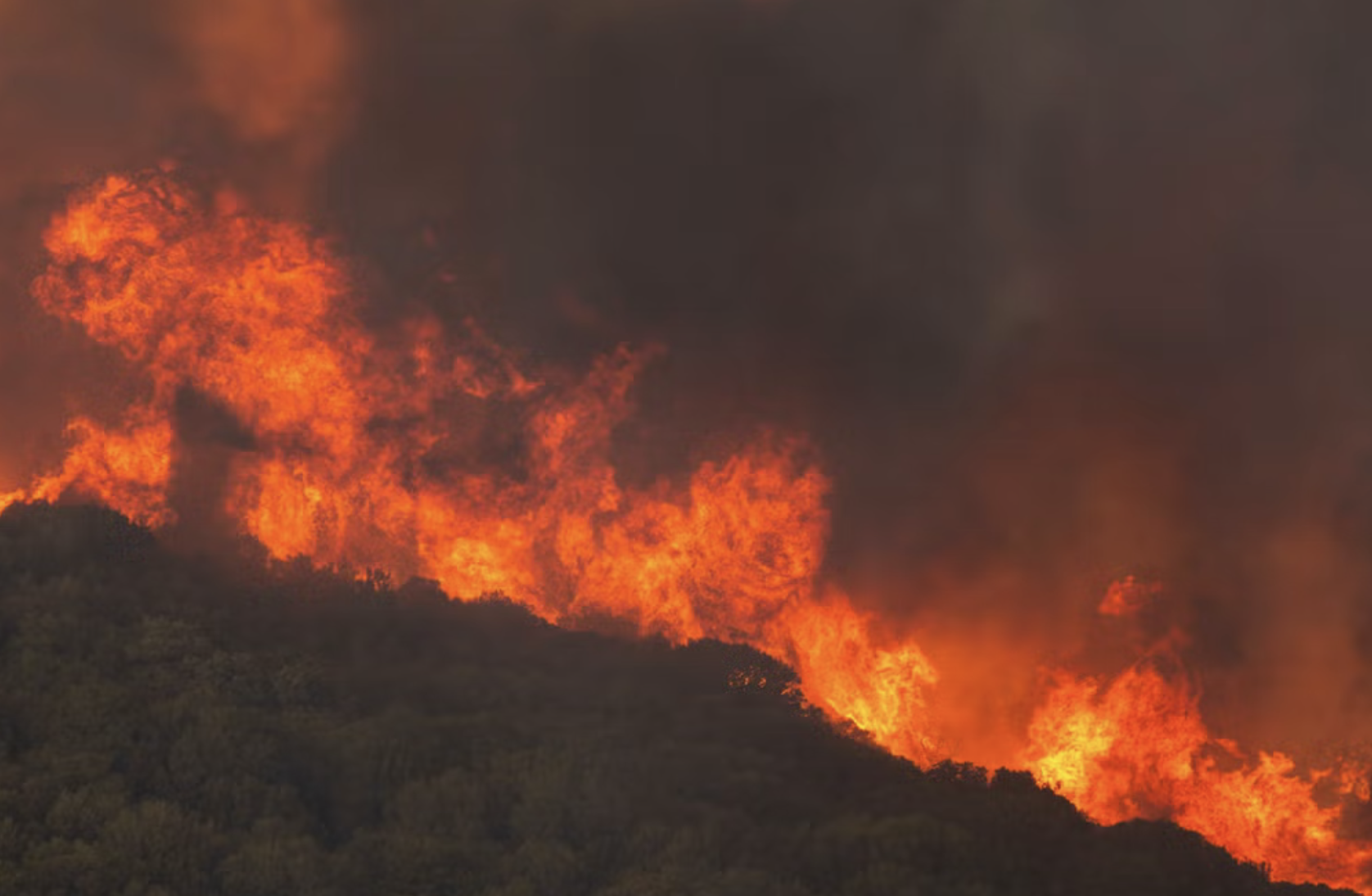
Wildfire burning in northern Greece. Image via Associated Press
Where did these fires coming from? Some say that unusually high temperatures and strong winds literally fanned the flames of some of the worst wildfires seen in decades. In addition to the devastating loss of lives and livelihood, vulnerable pieces of cultural heritage were severely damaged.
Now that the fires are no longer burning, cultural heritage experts around the world are able to identify scorched areas and initiate restoration efforts. Experts also pose this question: how to prevent such destruction by wildfire in the future? Especially when most of the world seems to take an ad hoc approach to cultural heritage restoration following natural disaster?
Greece
One of the hardest-hit areas was Greece. In August, Europe’s biggest wildfire in a century burned in northern Greece.
The fire covered an area larger than New York City, spanning 312 square miles. (For reference, New York City’s solid ground measures 302.6 square miles). Flames from this fire in northern Greece – primarily covering the regions of Evros, Rodopi, Alexandropoulis, Dadia, and northwestern Athens – proved devastating. The flames eradicated housing, farmland, and most of a national forest. In Evros, many took part in forced evacuations but, tragically, many lives were lost to the fires.
In early August, shocking damage occurred on the Grecian island of Rhodes. Satellite images showed Rhodes as a black scar of extensive damage. Evacuations in response to the flames forced thousands of residents to flee their homes and tourists to abandon their accommodations. The evacuations also prevented tourists from visiting cultural heritage hotspots that the island is known for. Namely, its legendary medieval village – a storied and mysterious acropolis built by crusaders within 4-km-long medieval stone walls.
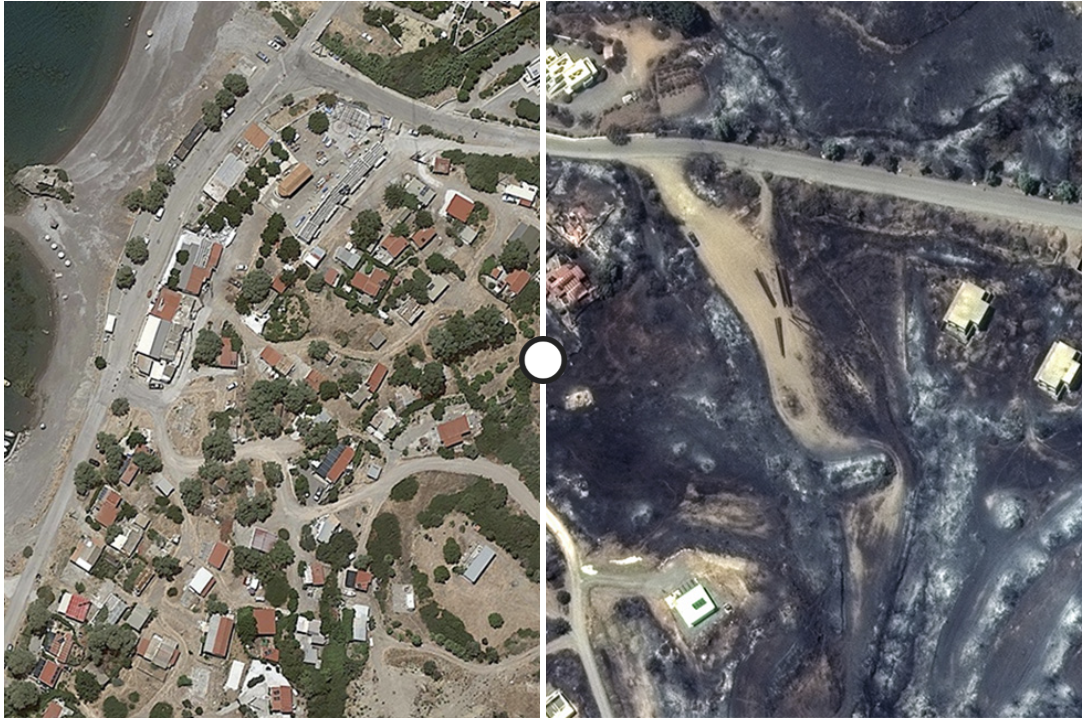
Side-by-side aerial photos of Rhodes, Greece takein in 2019 (left) and 2023 (right). Image via BBC News.
From the beginning, this medieval town has been imbued with legends and dreams of glory. According to the island’s history, Rhodes was transformed into a fortified city by the Knights of St. John of Jerusalem in 1309. The Knights’ occupation was so strong, in fact, that they held the island until 1523 – surviving several takeover attempts by Turkish and Egyptian conquerors.
Military prowess aside, the Knights outdid themselves in terms of city planning. Once on the island, rather than destroying the “ancient core” of the place (which was a perfect grid – the product of 408 B.C., Hippodamian-style city planning), the Knights incorporated their plans for a fortified center as an extension of the ancient design. They further divided the town into a northern quarter, called the “Chateau,” and a southern quarter, called the “Ville.” The Chateau was where the Knights would hang out in their personal residences. They also made sure to stop by the palace of the Grand Master of the Order, which was bigger and fancier than their own abodes. Additionally (and likely for their own convenience), the Knights also made sure that all of the administrative buildings, hospital, and cathedral were located in the northern end. The Ville, in contrast, housed the laity. It’s also where the synagogues and other churches were constructed, as well as the noisy (and predictably odorous) public street market.
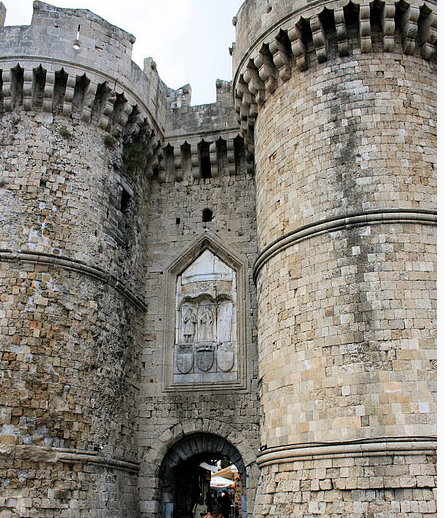
Medieval City of Rhodes. Image by Olbertz via Wikipedia.com.
When the Knights constructed these buildings, they went all-out in terms of style. Gothic and Renaissance designs, with a hint of Ottoman influences and a touch of Byzantine detail, manifested in a sensational conglomeration of art and architecture. Some of the buildings originally constructed as churches were later converted to mosques. Of the sacred spaces that remained churches, Agia Triada (the Holy Trinity), Agios Athanasios (St. Athanasius), Agia Alkaterini (St. Catherine), and Panagia tou Kastrou (the Virgin of the Castle), house gorgeous pieces of art and cultural heritage. The church of Agia Triada, for example, boasts stunning, original frescos. Sections of the fresco depict scenes from Ezekiel’s prophetic visions in the Bible. Other portions illustrate powerful images of Jesus’s Crucifixion on the Cross. And those frescos only scratch the surface in any tourist’s quest to discover the cultural heritage on this illustrious island.
Thankfully, the fires on Rhodes were eventually contained. Damage reports following the fires in Greece allowed cultural heritage to assess where restoration efforts would be needed. Inspections by the Climate Crisis and Civil Protection Ministry teams revealed the status of various architectural structures on-site. On Rhodes, six buildings were been designated by officials as unsafe for use. Twenty-two additional buildings were declared temporarily unfit, and seventeen others have been flagged as needing minor repairs.
The worst damage on Rhodes seems to have occurred in the local areas containing homes, hotels, businesses, and nature reserves. In fact, more than fifty homes, several popular resorts, and over 50,000 olive trees – a source of income for locals – were completely destroyed. Religious sanctuaries also suffered. The Monastery of Panagia Ipseni, in particular, became a verifiable inferno. The monastery’s olive orchards, vineyards, and religious icon workshop (all of which provided additional income for the monastery) were destroyed by the fire. The nuns – thankfully – were spared, yet had to endure watching their home erupt in flames, and their beautiful mosaic courtyard disappear under a layer of soot and ash.
However, the medieval city of Rhodes emerged relatively unscathed – possibly due to location and sheer luck. Even so, it is essential to acknowledge that, for Rhodes’ cultural heritage, escaping total destruction by wildfire was a very narrow victory. Moreover, even minor, “cosmetic” damage to ancient structures by wildfire smoke and extreme temperatures causes deterioration. The charred buildings, such as those seen in Lindos, indicate extensive damage to architecture. Extreme elements threaten to accelerate natural deterioration of delicate art within the medieval city. This alone poses increased dangers for those wishing to preserve Rhodes’ storied history. Restoration and preservation work must be given funding when rebuilding the city from the ashes in order to maintain Rhodes as a cultural heritage destination. Additionally, Grecian officials should consider enacting proactive measures geared toward cultural heritage, as well as putting in place orchestrated fire response protocols. Proactive preservation and planned response teams may save the day if this delicate art and architecture is threatened by natural disaster again.
Croatia
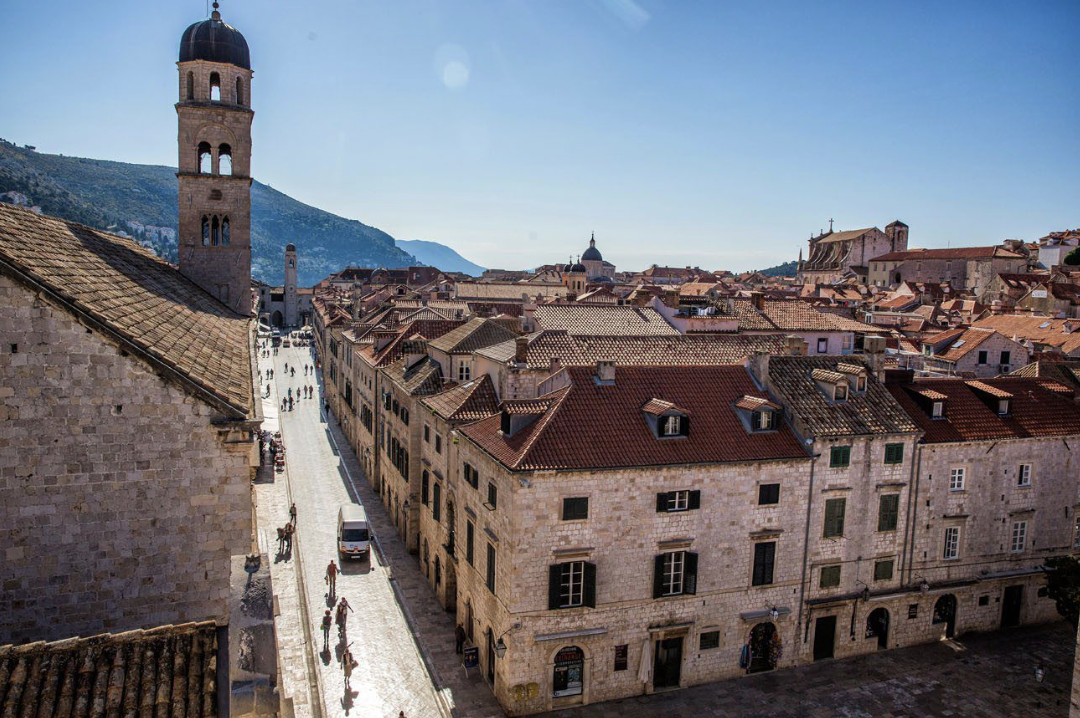
The Dubrovnik Walls in Croatia. Image via earthtrekkers.com.
Croatia’s stunning city of Dubrovnik marks a second European medieval town that narrowly escaped complete destruction of cultural heritage by wildfire this summer. Those lucky enough to have visited Croatia known that Dubrovnik houses vast artistic and architectural treasures. The Old City of Dubrovnik, referred to as the ‘Pearl of the Adriatic’, is listed as one of UNESCO’s World Heritage Sites. Dubrovnik emerged as a powerful city on the Dalmatian coast in the 13th century. The resulting influx of financial wealth produced a city that is a true jewel of art and artistry: Dubrovnik acts as guardian for an array of stunning churches, monasteries, palaces, and fountains. Each exquisite work of architecture demonstrates a celebration of Gothic, Renaissance, and Baroque artistic styles.
Last summer, fires in Croatia spread just south of the ancient city. Firefighters bravely fought to contain the fire, as an additional concern was that the wildfires would set off aircraft and landmines leftover from war in the 1990s. Deployment of the explosives would have posed even greater danger to the city and its beautiful cultural heritage. Fortunately, the southerly winds shifted and, with the aid of emergency personnel on the ground, Croatians were able to protect Dubrovnik’s residents and cultural heritage from damage.
Hawaii
The wildfires on Maui, Hawaii came as a shock to Americans – and were heartbreakingly deadly. 97 people were confirmed deceased, many of them children. In light of this, it is imperative to point out that the loss of cultural heritage is not the worst outcome of wildfire. Loss of human lives is the greatest tragedy; in events of wildfire and all other forms of natural disaster, loss of lives calls for our upmost recognition and respect.
The following discussion on the implications of damage done to Hawaii’s cultural heritage in the wake of the same fire should by no means overshadow the lives lost. Rather, it is intended to bring awareness to the delicacy of cultural heritage on the island, in the hopes that, by doing so, we may greater protect it in the future.
Lahaina, on the island of Maui, maintains an important place in the history of Hawaii. Listed on the National Register of Historic Places, the town rose to prominence as a whaling city in the mid-1800s. Interestingly, Lahaina was also the location of a printing press that produced the first-ever newspaper printed in the Hawaiian language. The four-page weekly paper, printed on Valentine’s Day, 1834, was called “Ka Lama Hawaii.”
Missionaries that arrived in the 1820s built Western-style architecture, including the Baldwin Home. The home was built by Rev. Ephraim Spaulding in 1834 – the same year as the Ka Lama Hawaii’s debut publication. Rev. Spaulding later returned to Massachusetts, and then lent the house to Rev. Dwight Baldwin (for whom the home is now named). Why Rev. Spaulding chose to live in the snowy echelons of Massachusetts, as opposed to the gorgeous views of Lahaina, is anyone’s guess. Regardless, the Baldwin House has since been converted into a museum, and is believed the be the oldest-surviving residence on Maui. A visit to the museum is a lesson in missionary life in an 1820s Hawaiian village – visitors can expect a tour of the house and grounds, as well as a peek into the vibrant, busy lift of the Baldwins’. The family knew how to throw a good party, and often received members of Hawaii’s royal court. For Lahainans in the 1840s, it was the place to see-and-be-seen.
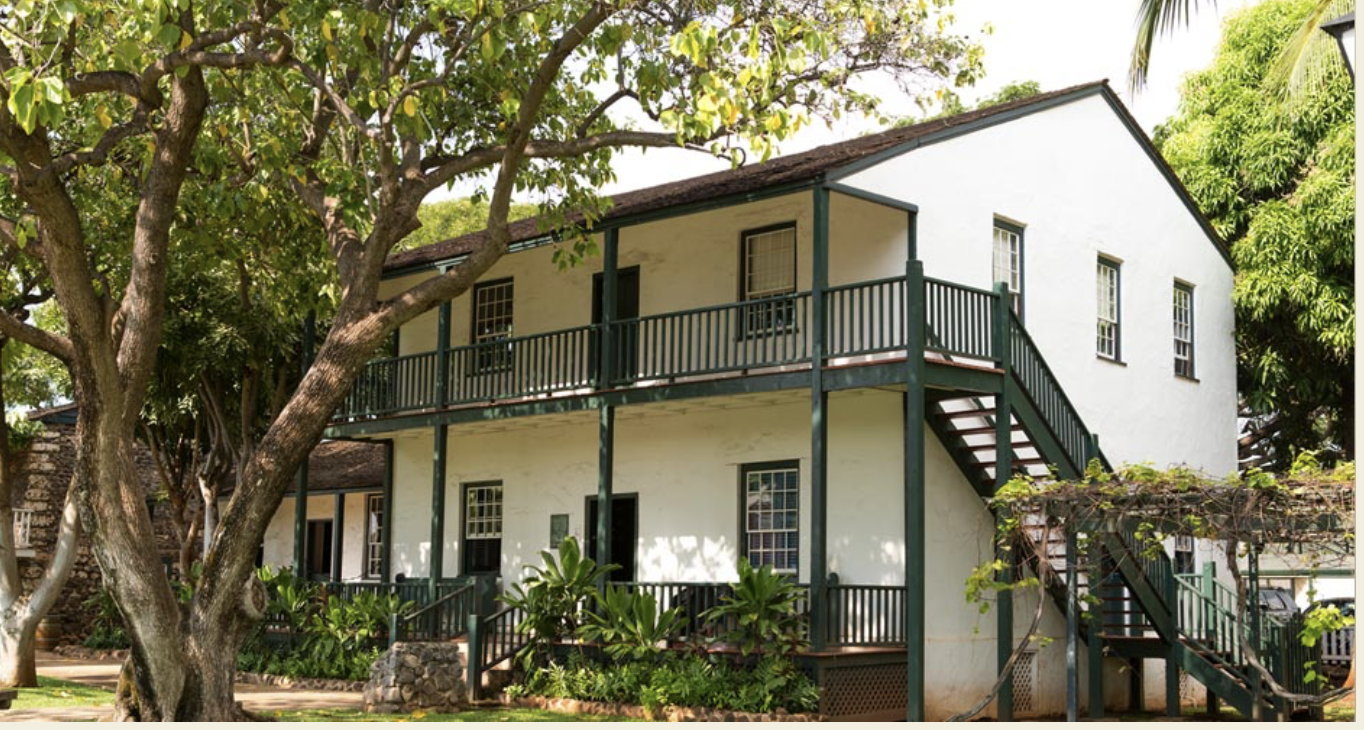
The Baldwin Home on Lahaina in Maui, Hawaii. Image via Lahaina Restoration Foundation.
Unfortunately, the Baldwin Home is one of many buildings that suffered extensive damage in the fire. The House had a wooden roof, which was completely burned by flames. The Baldwin Home Museum’s director, Theo Morrison, stated (shortly after the fire) that he suspected “the entire building was gutted.” This was later confirmed.
As more reports following the fire on Maui were released, damage to other precious cultural heritage sites on the island was to be expected. Reports – most tellingly, those from Native Hawaiians – revealed that cultural landmarks, art, and architecture crucial to the Hawaiian cultural narrative were destroyed. This includes sites on Lahaina were the first Hawaiian Constitution during the kingdom era was written in the 1800s, and an ancient fish pond where Hawaiian monarchs were known to take their rest and leisure.
Although Maui is often touted as a tourist site, for Native Hawaiians, it has been long-known as the heart of their storied history. In this light, the impact of cultural heritage lost by the wildfires points to the power and enduring influence of irreplaceable art, artifacts, and historic sites. The art community must look to ways to proactively prevent vulnerable pieces of cultural heritage from destruction by extreme natural weather events. The reality is that damage done to treasured works of art and cultural heritage anywhere causes the world to lose crucial components of shared human history.
Who’s to Blame?
As the world continues to reflect on the summer wildfires, many seek to find a scapegoat for the destruction. Climate change, arson, and inefficient government response teams have all been blamed. However, at this stage in the world’s evolution, pointing fingers does little to solve the problem at hand. Loss of delicate art and cultural heritage by natural disaster is part of the new normal. If art is to be preserved for future generations, proactive protection measures should be the first line of defense.
The second line of defense should be an increased awareness of the importance of preserving such heritage, and a place for that awareness in planning for orchestrated response efforts.
The third line of defense? It’s a call to individual action, and it comes from Smokey.
by Amineddoleh & Associates LLC | Sep 29, 2023 |
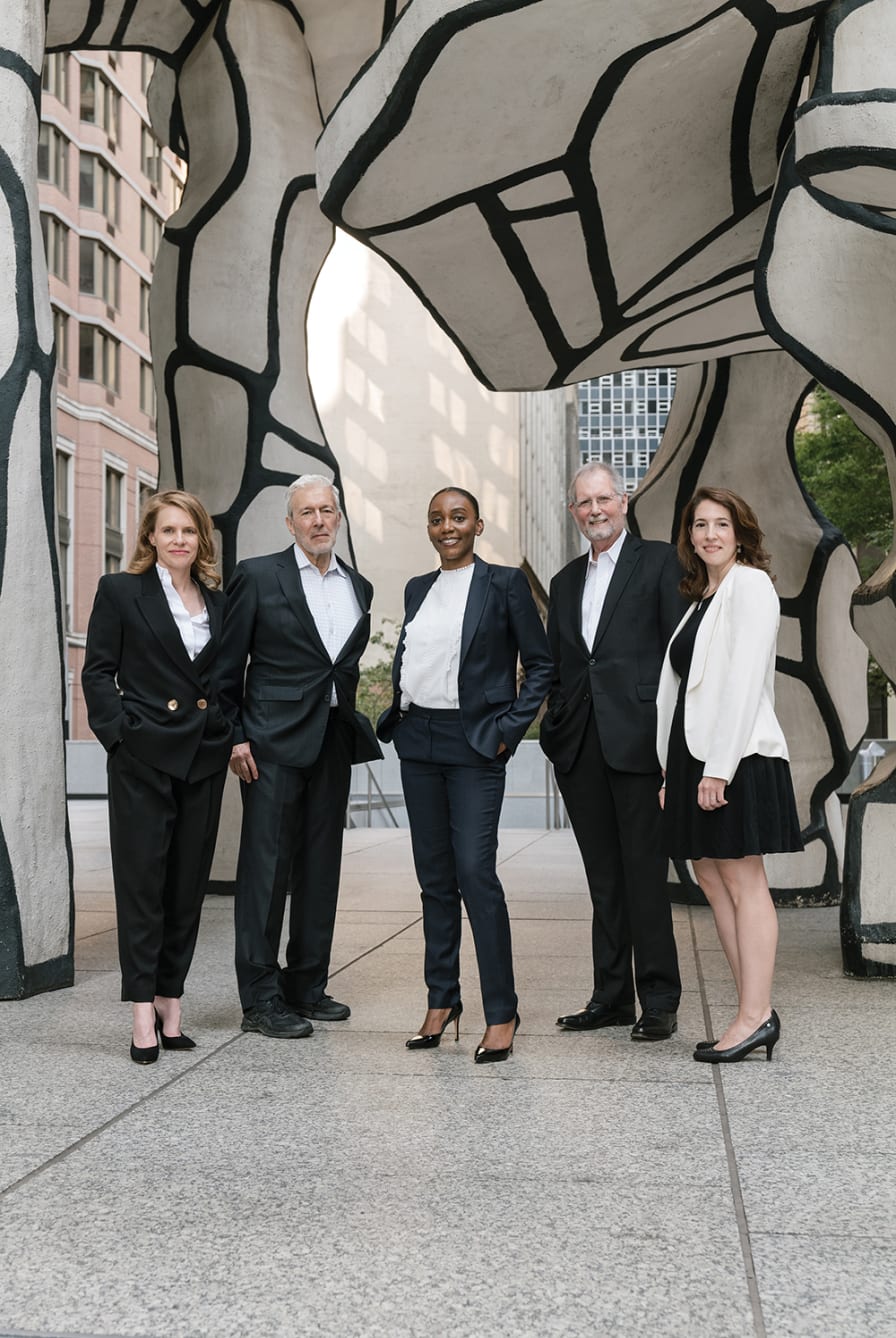 Our founder, Leila Amineddoleh, has recently been featured in New York Metro Super Lawyers Magazine, alongside other leaders in her field. Leila was chosen for the piece as a top-rated intellectual property, art, and cultural heritage lawyer well-known in the industry for getting the job done right. This means advocating both for her clients, and for the art and cultural heritage at issue.
Our founder, Leila Amineddoleh, has recently been featured in New York Metro Super Lawyers Magazine, alongside other leaders in her field. Leila was chosen for the piece as a top-rated intellectual property, art, and cultural heritage lawyer well-known in the industry for getting the job done right. This means advocating both for her clients, and for the art and cultural heritage at issue.
In the article, Leila’s experience working with our former client (and now current friend) Laura Young, is highlighted. Young is our client who found an Ancient Roman marble bust at her local Goodwill in Austin, TX. Our firm has written previously about Leila’s and Laura’s story. Read the incredible journey one Roman bust took from Germany to Texas (and how he found his way home) here.
In the piece by Super Lawyers, Leila’s success working with Laura is illustrative of her signature manner taking care of her clients by providing insight on best practices in the art law field. In Leila’s words, her work as a lawyer requires giving this special level of attention. She says it can require coming up with “creative solutions . . . . As a lawyer, you find out what’s important to someone.”
Later in the article, Leila gives her thoughts on changing attitudes on lawsuits involving stolen antiquities. She connects the rise of modern lawsuits brought by claimants for contested works to a 1995 international investigation in Italy. That investigation exposed many thought-to-be honest dealers as thieves, and revealed and auction houses to be engaging in deceptive practices. Leila explains how the impact of this investigation continues to call objects held by museums, collectors and auction houses into question, leading to an on-going return of hundreds of objects and works of art.
Leila’s success has launched her and her namesake firm to even greater heights. It is an honor to be featured alongside other esteemed colleagues this stand-alone piece. In it, Leila and her colleagues give important guidance on the current industry challenges for art lawyers. Read the piece here.
by Amineddoleh & Associates LLC | Jul 27, 2023 |
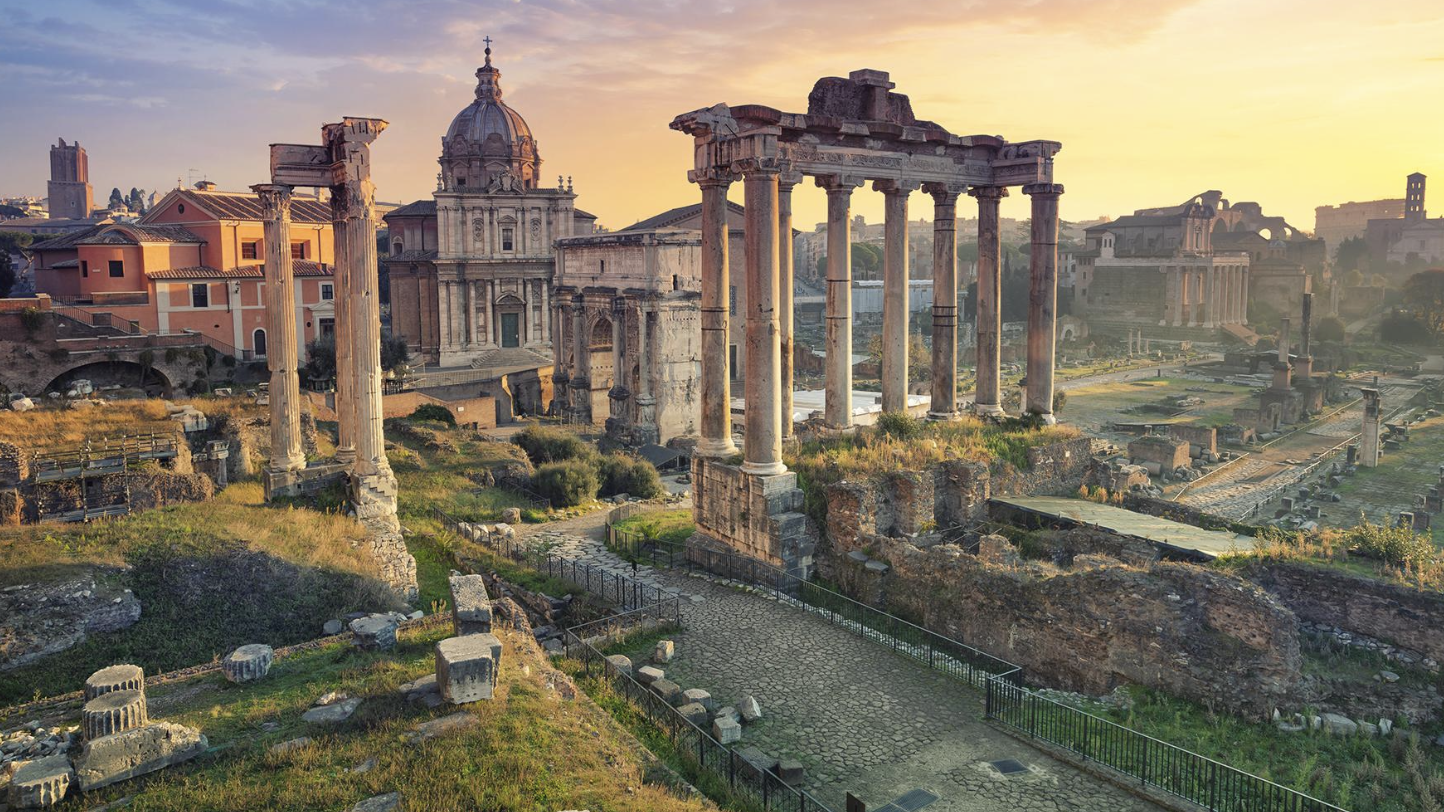
Roman Forum. Image via Fodor’s, available at https://www.fodors.com/world/europe/italy/rome/experiences/news/photos/the-10-best-ancient-sites-in-rome.
Our firm is pleased to continue our collaboration with the American Institute for Roman Culture (AIRC) in their Ancient Rome Live Series. Those familiar with the AIRC’s work will remember our firm’s past contributions to the series, which are available here.
For those who are just learning of AIRC and their work, the AIRC is an internationally-acclaimed non-profit founded in 2002 to promote Italian culture. AIRC provides opportunities for education, archeology, and study abroad, with locations in both the U.S. and Italy. AIRC’s founder, Darius A. Arya, is an archeologist, public historian, author, social media influencer, and TV host based in Rome, Italy. In his role as AIRC CEO, Dr. Arya leads lecture series, heritage preservation initiatives, teaches bespoke educational courses, and hosts a highly-rated podcast called Darius Arya Digs.
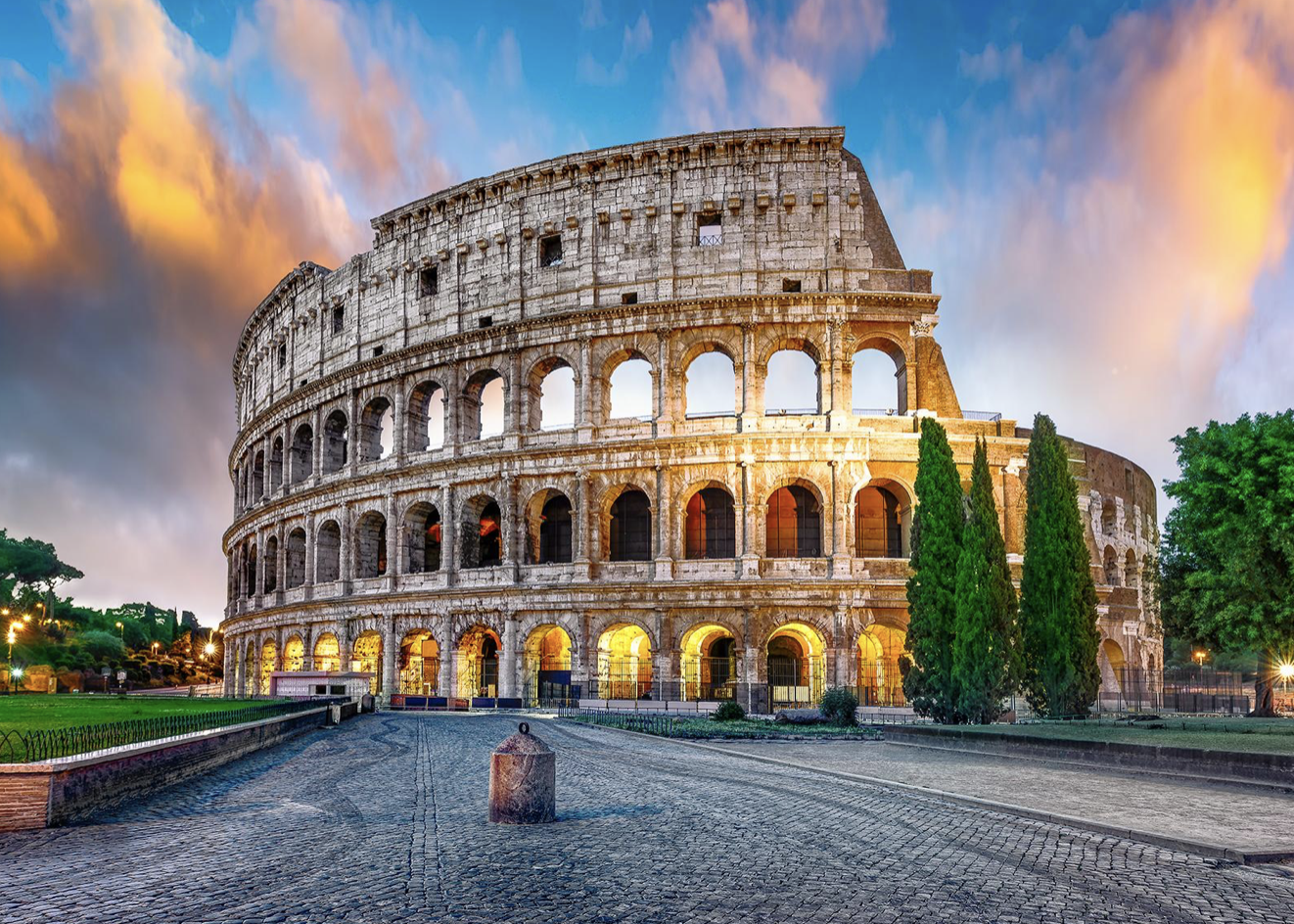
Colosseum. Image via Fodor’s, available at https://www.fodors.com..
Our firm’s most recent contribution tackles the complicated (and extremely timely) issue of overtourism. Following the opening of international borders, tourists have flocked to cultural heritage hotspots around the globe. The sudden influx of tourism to cultural heritage sites seems to be a symptom of “revenge tourism,” the product of isolating at home during the pandemic. While re-engaging with travel in a thoughtful way no doubt fuels local economies and broadens the mind, thoughtless travel often results in the destruction of priceless pieces of cultural heritage.
Interested? Read the entire article on the Ancient Rome Live Series website, here.
AIRC has been an awarded an NEH grant, an American Express Foundation grant, and a World Monuments Fund (WMF) collaboration. AIRC receives additional funding from anonymous angel investors and individual donors. If you would like to contribute to AIRC and Dr. Arya’s world-class courses and promote opportunities for lifelong learning, you may support the organization here.
by Amineddoleh & Associates LLC | Jul 24, 2023 |
Art Nouveau fans rejoice: July 24th is the late Alphonse Mucha’s birthday. This year’s anniversary comes with a bit less fanfare than his 150th in 2010, when Google created a doodle on the artist’s behalf.
But even without a doodle from Google, Mucha’s legacy continues to influence art and artists around the world. One aspect of his enduring legacy is how his work influenced the rise of celebrity art. This phenomenon has been popping up more and more frequently in American culture, and no one (not even celebrities themselves) are immune from the draw of star power.
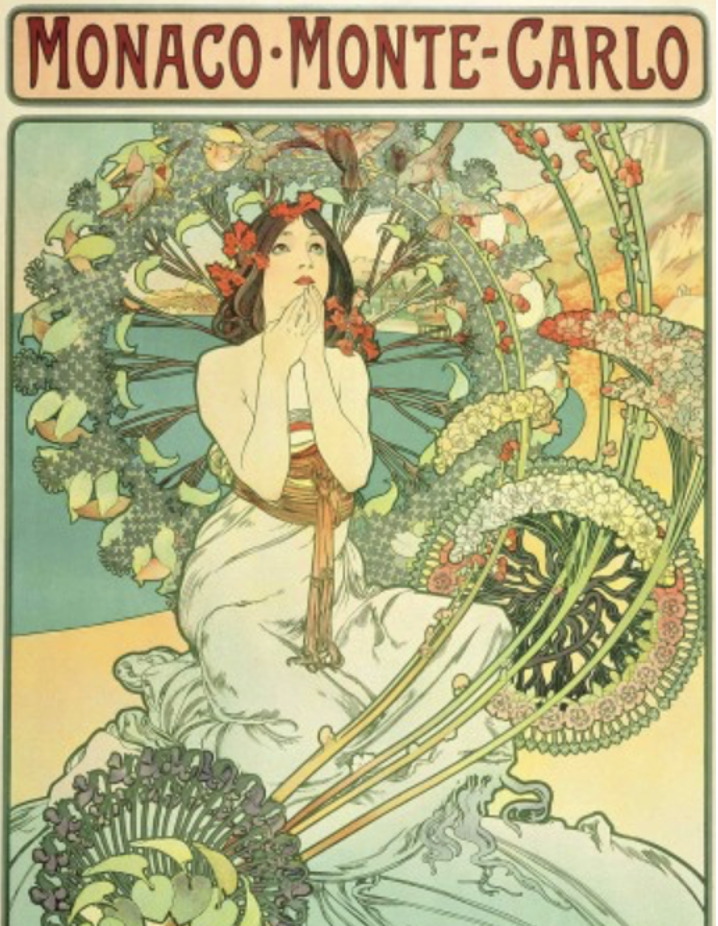
Modern Celebrities Embrace Art
No longer playing the role of pirate, actor Johnny Depp has swapped his sword for a paintbrush in real-life. It seems to have been a sound business move. The actor made a staggering $3.6 million selling works from his first “Friends & Heroes” art collection in 2022. His second, entitled “Friends & Heroes II” was released in February. It is comprised of four portraits of artists that have inspired Depp throughout his life: Bob Marley, Health Ledger, River Phoenix, and Hunter S. Thompson. An unbelievable answer to the classic “Dream guests at a dinner party?” question, if ever one existed. Almost already entirely sold out – all that remains on the Castle Fine Art website is a pack of all four prints, priced at a swashbuckling $20,416.67.
Depp’s foray into celebrity art highlights modern culture’s fascination with all-things celebrity. Are Depp’s works prized due to his creative talent as an artist? Or are the pieces selling because they are exclusively of famous celebrities? Or, possibly, Depp is able to sell out faster than Taylor Swift tickets because he, himself, is a celebrity? Which points to the threshold question: when did artists begin to feature celebrities in art? Many art historians look no further than the incredibly gifted Alphonse Mucha, who skyrocketed his own career to greater heights through his collaboration with a famous actress.
Rise of Celebrity Art
“If you have to explain to someone you’re famous, then you’re technically not that famous.”- David Spade.
The beauty of Alphonse Mucha‘s work stems from his deep passion as an artist. Many artists are known for having a lot of gusto, but Mucha really takes the cake. He was master of the Art Nouveau style of art, so masterful in fact that many credit his career for influencing major tenants of the age – politics, religion, philosophy, and – of all things – the career of one very famous actress named Sarah Bernhardt.
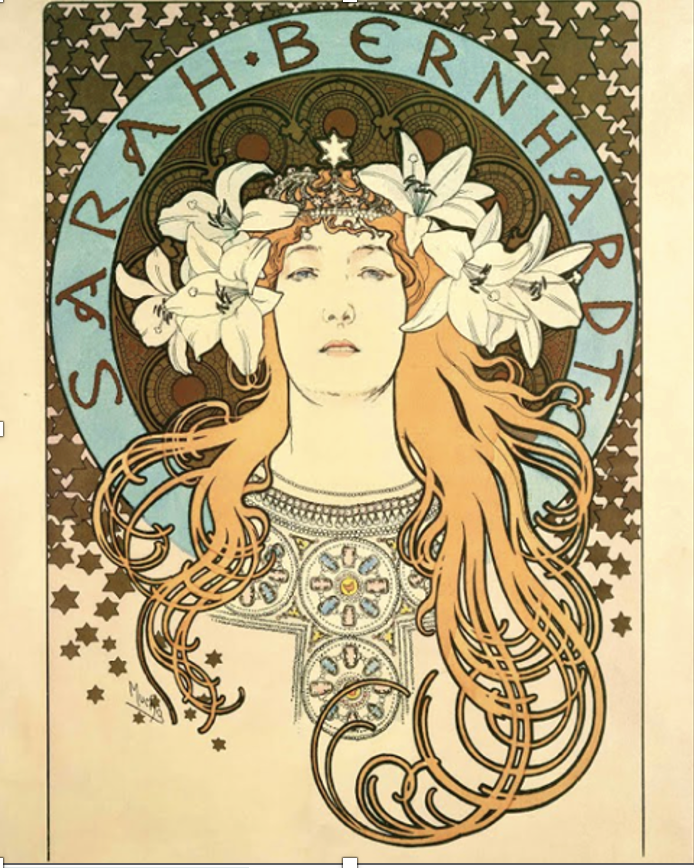
Alphonse Mucha, Poster for ‘La Plume’ magazine (1897). Image via muchafoundation.org.
Before we get to Sarah, a little more about our man Mucha. He was born on July 24, 1860, in a quiet town in Moravia. In his youth, Mucha was – in his own words – “preoccupied with observing.” This tendency to notice things around him manifested in a profound artistic talent. Young Mucha could be found making sketches and drawings for friends, family, and fellow townsfolk. His drawings were so prodigious that he collected quite a few fans, even in his early days. One fan was the town’s shopkeeper, who often slipped Mucha free sheets of a paper – a luxury of the day – in order for him to make his creations.
As Mucha grew older, his artistic talent also matured. When he was 18, he was ready to apply to the Academy of Fine Arts in Prague. Unfortunately, he was rejected. The admissions office even went as far to suggest he take up a different, “less artistic” career. I’m not sure what they had in mind (medical school?), but fortunately for us, Mucha was not discouraged for long. He decided to simply carry on and continued to make art in whatever way he could.
A year later, Mucha had a bit of luck – an opportunity arose for an artist to work with a Vienna newspaper making advertisements. The pay was pitiful, and Vienna is freezing cold in winter. However, Mucha forged ahead, desperate to create. He applied, scored the gig, and packed his bags for his journey to the big city.
This was a turning point in Mucha’s development as an artist. He spent two years in Vienna, creating advertisements for the paper by day and taking art classes by night. What this did was cement in him a love for creating artwork that was accessible to the average, everyday person. He thrived on creating beauty in pamphlets, posters, and advertisements that most companies and institutions did not have the time or talent to make elaborate. We can start to see, from this period, the development of certain curvature in his lines, and repetition of old world-inspired motifs come up again and again in works that would inevitably become a part of an ordinary person’s daily life.
Mucha retained this love of creating beautiful and accessible work, while still seeking to enhance his skill as an artist through more formal training. Eventually, he applied to – and was accepted to enroll in – the Academy of Fine Arts in Munich in September of 1885. This provided Mucha with formal artistic skills, though it is important to note that Mucha is still believed to be largely self-taught as an artist (which could also mean that he ignored much of what was taught in school). From Munich, he made his way to Paris: the art capital of the world at the time.
In the City of Lights, he established himself as a “reliable” illustrator (as noted by his biographers). The Paris theater scene is where the lives of Mucha and the phenom Sarah Bernhardt intersect. Sarah Bernhardt is often touted as the original “true superstar.” This is before the current fame-cycle of Hollywood starlets, who now can be seen as a dime a dozen, splashed across the covers of People magazine.
Sarah Bernhardt was the real-deal – a woman with the poise, charisma, and gumption to make a name for herself as an actress against the backdrop of a politically tumultuous city. Not only is she remembered as a strikingly impactful actress, known for her talent, she is also regarded as the first superstar known to personally exploit her own image and likeness for economic gain, and to raise her own fame. This is an important piece of the puzzle of a topic referred to as “publicity,” which we’ll address later.
Mucha began working with Bernhardt in December 1894, in a serendipitous sort of meeting that can only be attributed to fate. Bernhardt’s play, Gismonda, was set to open on January 4th, 1895. On December 26th, 1894 – just a few short days before opening night – the starlet decided that her show needed a new poster to publicize the play. Something dazzling. Something that would leave Paris speechless.
She turned to the manager of a Parisian printing firm for a new poster, pronto. Given the short notice, and the fact that Bernhardt approached the firm in the middle of the Christmas break, Maurice was short on options for the commission. In desperation, he turned to Mucha – truly the only option at hand – and begged him to take on the job. Ever the flexible type, Mucha agreed. And, in doing so, a true collaboration between two legendary artists was born.
The success of Mucha and Bernhardt’s eventual career-long collaboration is likely because the two saw eye-to-eye on Sarah’s talent.
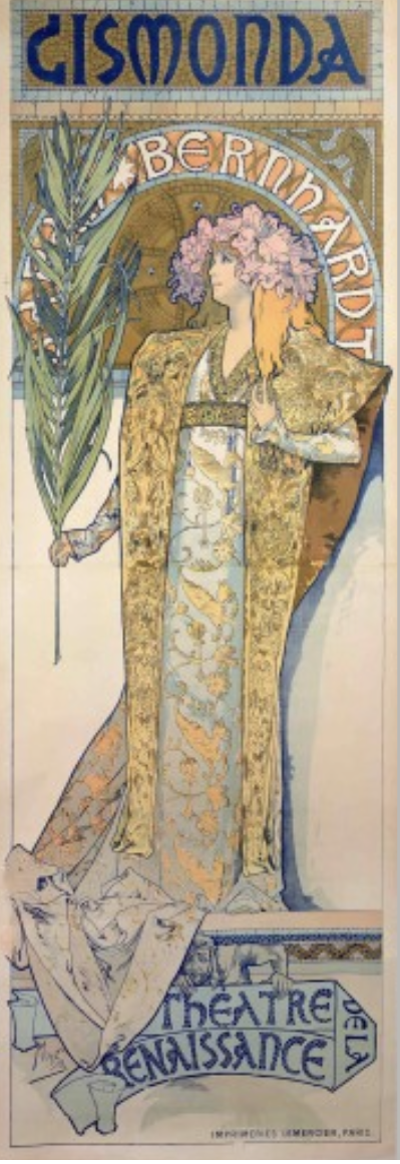
Alphonse Mucha, Poster for ’Gismonda’ (1894). Image via muchafoundation.org.
In other words, Mucha was a fan. In creating the poster for Gismonda, he relied on his personal knowledge of the play itself, as well as his fascination with how Bernhardt depicted the title role. The result? A stunningly ethereal piece that focused the viewer of the poster on the actress herself, rather than on fussy knickknacks in the background. The poster was truly a spotlight on Sarah, in all her glory – and Sarah loved it.
Thus, the two kicked off a mutually beneficial partnership. Bernhardt became Mucha’s artistic muse and mentor in the industry. They also became very good friends. Each seemed impressed by the other’s commitment to creativity, and fervent refusal to be fenced in by artistic norms of the day. Sarah, for her part, pushed the boundaries of Parisian theater by lobbying for politically impactful roles. Mucha, on his end, blazed a trail as a high-end artist for the lower strata of society.
Much of the work Mucha did for Sarah was accessible to the everyday Parisian, because her giant posters were displayed on the street. And, he created many posters of Bernhardt in her various roles throughout the remainder of her career. Because Mucha continued to make Bernhardt the star of each new poster, his work served to elevate her career to even greater heights. In this way, Bernhardt was able to exploit her own image and likeness to increase her status as a public figure – and was one of the first known celebrities to ever do so.
The upside for Mucha was that, because of his work that featured Sarah, he became higher-in-demand as an artist for other jobs. Mucha became more famous and earned more money because he painted someone famous.
Collaboration v. Exploitation
Mucha’s portrayals of Sarah Bernhardt in his artwork were clearly a collaboration. But, using a celebrity’s image in a work of art does bring forth a question: when can an artist legally make use of a person’s image or likeness in a work of art, if use of that image increases the economic value of the work itself?
Modern Legal Framework & Application
To answer this question, two rights come into play. Both come from state, rather than federal law, and are mostly understood through case law.
The first right is called the right of privacy. This means is that private people have the right to prevent the public disclosure of their name and likeness by others. For example, if a company started using a private person’s face as the logo for a brand of salad dressing, that person could bring an action against that company claiming the right of privacy.
The second right, which sounds similar, but functions very differently, is called the right of publicity. That right means that a person has the right to exploit her own image and likeness for her own economic gain. Using the salad dressing example, this is why “Newman’s Own” salad dressing uses his face on the label. His company profits from the use of his public image on its products. The right belongs to Newman’s heirs, because the value of his image is the fruit of his own hard work as a famous actor. (Confusingly, what is referred to as the right of privacy in New York is, in fact, the right of publicity).
Sometimes, the aforementioned rules change if, instead of, as in the example, an advertiser using the celebrity’s image, the person using the celebrity’s image is an artist creating a work of art.
Some courts have held that any work created by an artist, even if it uses a celebrity’s image, is a form of free expression. The First Amendment protects free speech. Included in the many categories of free speech is art – it’s speech, even if it doesn’t make noise.
Courts that have broadly interpreted the First Amendment free speech protection in cases where an artist uses a celebrity’s image in their art have generally permitted it. According to these courts, if artist’s use of the celebrity image is a form of free speech, it is allowed. However, the application of this principle is not as straightforward as it might appear. While some courts have given artists broad discretion under the First Amendment to use celebrities in their works, other courts have sided with celebrity defendants, under the theory that the artist’s work violates the celebrity’s right of publicity.






 Our founder, Leila Amineddoleh, has recently been featured in New York Metro Super Lawyers Magazine, alongside other leaders in her field. Leila was chosen for the piece as a top-rated intellectual property, art, and cultural heritage lawyer well-known in the industry for getting the job done right. This means advocating both for her clients, and for the art and cultural heritage at issue.
Our founder, Leila Amineddoleh, has recently been featured in New York Metro Super Lawyers Magazine, alongside other leaders in her field. Leila was chosen for the piece as a top-rated intellectual property, art, and cultural heritage lawyer well-known in the industry for getting the job done right. This means advocating both for her clients, and for the art and cultural heritage at issue.



